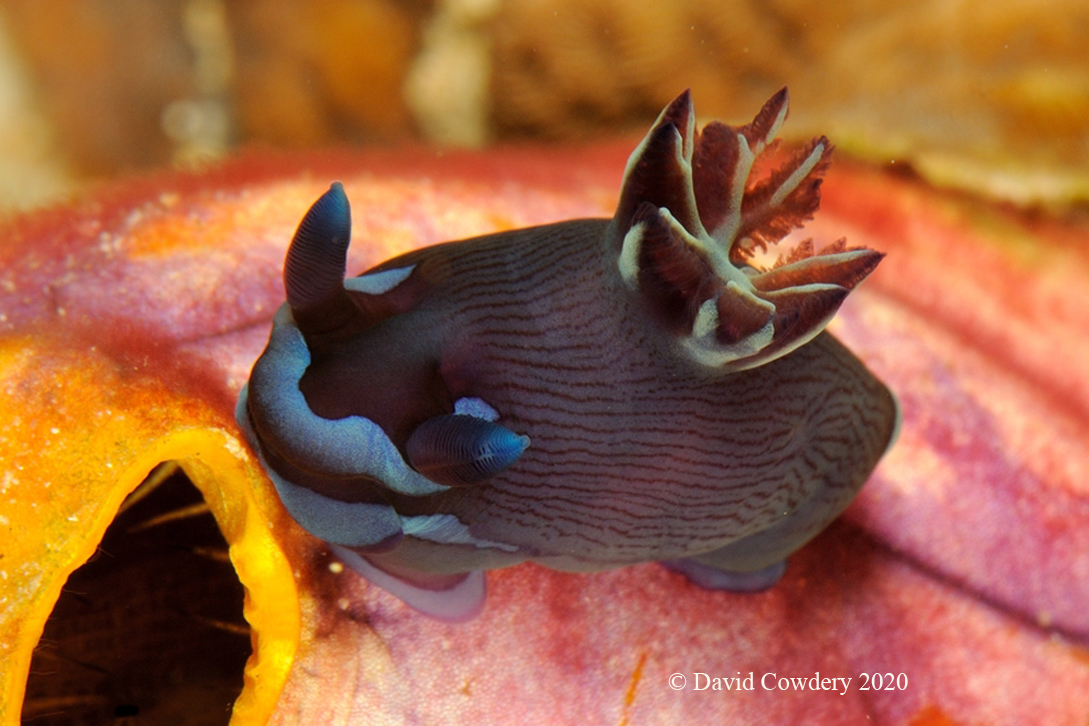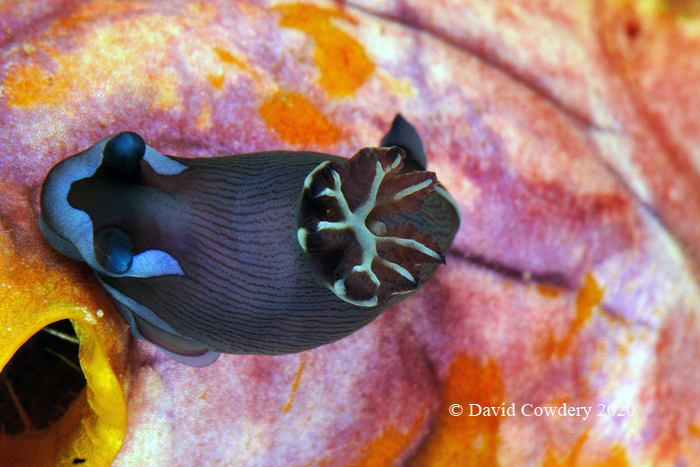 |
Image courtesy of David Cowdery
Padar Island, Komodos, Indonesia
|
Image courtesy of David Cowdery Padar Island, Komodos, Indonesia  |
Tambja cf. morosa (Bergh, 1877) Tambja morosa is an extremely common and variable species , but it always has a blue marking on the head and along the edge of the foot. Also the rhinophores are black with a greenish to bluish tip. David's specimen has these consistent markings, but it also has undocumented, interesting fine lines down the notum. Due to its size, Terry Gosliner feels that this is a juvenile. David on the other hand is convinced it is a new undescribed species telling Mike and I - "if this is a juvenile Tambja morosa then why is it that in the huge number of images I have sighted of this COMMON species in various websites and on the internet, that no image I have ever seen looks remotely like my images. The chance of nobody ever sighting this COMMON species in the juvenile form seems entirely unlikely. I cannot reasonably doubt Terry Gosliner, but I am left with this conundrum. I have sighted many juvenile forms of COMMON species, but never one that looks so different to the adult like this one without any other photographer ever having captured a similar image. I leave you with this thought." David may be right - but we will likely never know. Webmaster Mike responded to him with this - "Yes, I went through Bill Rudman's site to see if anyone has posted anything remotely similar to your images! Nothing even close relating to the fine lines seen on the notum! I have never seen it before in my travels! So yes, we have a conundrum on our hands! The gill structure of your submission is suggestive of Tambja morosa but there still remains lingering doubt (as least in my mind) as to what we are dealing with! Now, let's address why a definitive answer to your question may be a long time in coming! The problem is this; all the insitutional labs in California that work on these kinds of challenges are shut down due to the corona virus pandemic! Even when they open up again, there will be a serious backlog of similar examinations to be made! |
That brings up the final hurtle which may never be overcome! Indonesia does not allow collecting without a permit, so in the foreseeable future there won't be any Morphological or DNA studies to discover the lineage of your guy and that is assuming we ever see it again!
And as you probably already know, the reputable journals that traditionally publish sea slug papers will not accept papers without proof of a collecting permit! Kind of a catch 22?
Perhaps in this BOW we can encourage readers to submit any images they may have regarding your find!
Best we can do at the present time."
Dave Behrens
Sammamish, WA 98074
Jul., 2020
Send Dave Behrens email at davidwbehrens@gmail.com
Send Mike Miller email at mdmiller1@cox.net

Dave Cowdery is a retired bio-medical Engineer and is the inventor of the Alumina/Titanium hermetic feedthrough (1970) for implantable bionics and the first to introduce a Titanium casing. This invention created the first bionic implant (pacemaker) with a service life that could be measured in years rather than months and is the basis for todays huge multi billion dollar bionic industry. David is a Divemaster with over 5,500 dives experience and is based near Byron Bay in Australia. David is also a keen competitive road bicycle rider covering over 400 km most weeks. Photographic equipment used Nikon D800 camera with DS160 substrobes.
Send Dave mail at divec@ozemail.com.au
|

Attention all you Sluggers, and you know who you are! The NSSI 2nd edition is now available in ebook PDF and book form . The hard back version will become available Nov. 1st. Both will cost $65 (individually). You will need to jump through a few hoops to get the electronic version as pdf distribution is protected by Adobe ID!! Please read the following to enable reading your electronic purchase! This new 2nd Edition is updated and reorganized, including 185 new species. Among other features, the new edition includes additional photographs of species, an identification key, and an up-to-date classification reflecting the latest evolutionary relationships. The Indo-Pacific represents the largest expanse of tropical ocean in the world, stretching from the Indian Ocean coast of southern Africa and the Red Sea to the central Pacific of the Hawaiian Islands, Easter Island and the Marquesas. This region supports the most diverse marine fauna of any place in the world for most groups of marine organisms. The nudibranchs and sea slugs are no exception to this rule; there are about 3,000 described species of these organisms in the world and at least 40% of these have been found exclusively in the Indo-Pacific tropics. This book illustrates 2,138 Indo-Pacific nudibranchs and sea slugs, including many undescribed species.
|

|
